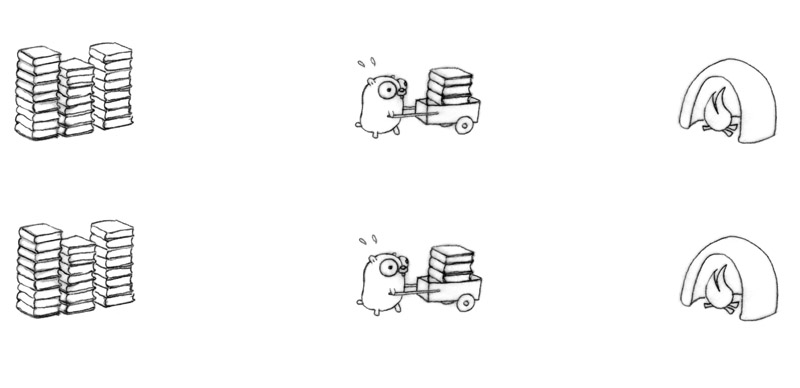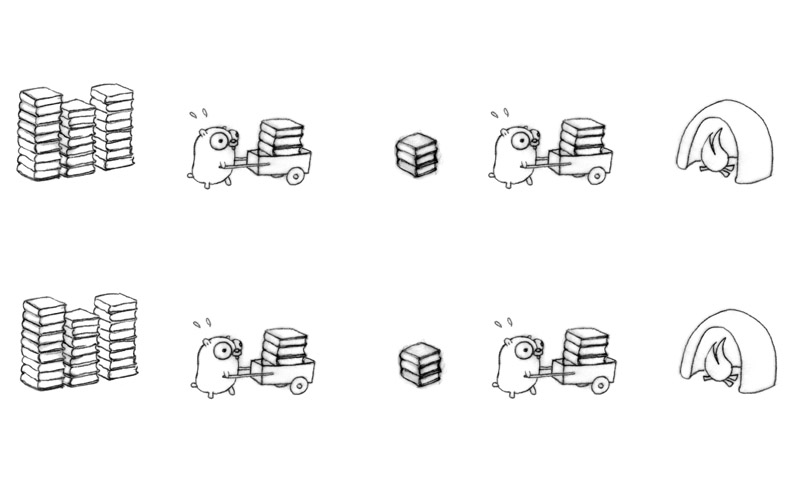Concurrency and Parallelism
CIS 193 – Go Programming
Prakhar Bhandari, Adel Qalieh
CIS 193
Prakhar Bhandari, Adel Qalieh
CIS 193
Simple I/O with ioutil
import "io/ioutil"
func main() {
// Read entire file
b, err := ioutil.ReadFile("input.txt")
if err != nil {
log.Fatal(err)
}
// Write entire file
err = ioutil.WriteFile("output.txt", b, 0644)
if err != nil {
log.Fatal(err)
}
}What's bad about loading the entire file into memory?
Provides buffered I/O
Creating a read buffer
import (
"bufio"
"io"
"os"
)
func main() {
// Open intput file
fi, err := os.Open("input.txt")
if err != nil {
log.Fatal(err)
}
// Read buffer
r := bufio.NewReader(fi)
...
}Creating a write buffer
func main() {
...
// Open output file
fo, err := os.Create("output.txt")
if err != nil {
log.Fatal(err)
}
// Write buffer
w := bufio.NewWriter(fo)
...
}Copying a file
func main() {
// []byte buffer for each chunk
buf := make([]byte, 1024)
for {
n, err := r.Read(buf) // Read a chunk
if err != nil && err != io.EOF {
log.Fatal(err)
}
if n == 0 {
break
}
// Write chunk
if _, err := w.Write(buf[:n]); err != nil {
log.Fatal(err)
}
}
if err = w.Flush(); err != nil {
log.Fatal(err)
}
}A system where several processes are executing at the same time - potentially interacting with each other
Concurrency is about dealing with many things at the same time
Has more to do with system design than execution - concurrency is a design property of a program where two or more tasks can be in progress at the same time (but not necessarily executing at the same time)
Examples?
Computation where many calculations are being done simultaneously
Often used for situations where large problems can be divided into smaller ones, which are solved in parallel
Parallelism is doing lots of things at once - run-time property where two or more tasks are being executed simultaneously
Examples?
Concurrency != Parallelism
Concurrency is about dealing with lots of things at once, Parallelism is about doing lots of things at once
Concurrency is a way to structure a program by breaking it up into pieces that can execute independently
Concurrency can let us structure a problem in a way that may (or may not) be parallelizable
Example adapted from Rob Pike's talk Concurrency is not parallelism
Problem: Move a pile of obsolete books to the incinerator

What components make up this task?
Problem: Move a pile of obsolete books to the incinerator

What components make up this task?
How can we speed this up?
One solution: Add another gopher and cart!

The pile and incinerator will have bottlenecks - we need to add some sort of communication between the gophers
This is concurrent composition!

Is this parallel?
The previous design isn't automatically parallel - however, it can automatically be made parallel
Concurrent designs aren't necessarily parallel, but can enable parallelism
Another concurrent design

Each gopher has a specific simple task
Potentially four times faster than the original one gopher design
We can now parallelize this system

Is this necessarily parallel?
There are lots of other concurrent designs

Once an efficient concurrent design has been made, parallelization can be added in
What does this example relate to?
Substitute:
We can think about this example as a concurrent design for a scalable web service
A situation where the program gives incorrect results for certain interleavings of the operations
In Go, this will happen with operations of multiple goroutines (more on these next week)
// Package bank implements a bank with one joint account.
package bank
var balance int
func Deposit(amount int) {
balance = balance + amount
}
func Balance() int {
return balance
}
Any sequential calls to Deposit and Balance should give correct results
Are they always sequential?
Let's add two functions for this joint account
func Rob() {
bank.Deposit(100) // R1
fmt.Println("Bank balance is ", bank.Balance()) // R2
}
func Ken() {
bank.Deposit(200) // K
}Possible interleavings:
Are there any issues with these orderings?
Are there any more cases?
Break up Rob's deposit into two components: read and write
func Deposit(amount int) {
balance = balance + amount
}Consider this ordering:
R1r // balance(R1r) = 0 K // balance(K) = 200 R1w // balance(R1w) = balance(R1r) + 100 R2 "Bank balance is 100"
How can we prevent this?
One potential solution: use mutual exclusion - only allow one concurrent process to access the shared variables at a time
Only the process with access to the "token" is allowed to do work
Mutexes in Go
func (m *Mutex) Lock() // Lock locks m. If the lock is already in use, the calling // goroutine blocks until the mutex is available. func (*Mutex) Unlock() // Unlock unlocks m. It is a run-time error if m is not locked on entry to Unlock.
import "sync"
var ( mu sync.Mutex // guards balance balance int )
func Deposit(amount int) {
mu.Lock()
balance = balance + amount
mu.Unlock()
}
func Balance() int {
mu.Lock()
b := balance
mu.Unlock()
return b
}
In the previous example, it is safe for two concurrent operations to access Balance(), as long as no Deposit() calls are being made
sync.RWMutex is a mutex that allows read-only operations to proceed in parallel with each other, but makes sure write operations have fully exclusive access
See sync.RWMutex for more details
Use the time package
Useful functions
time.Now()time.Since(t Time)How to time a function?
func timerFunc(start time.Time, name string) {
elapsed := time.Since(start)
fmt.Printf("%s took %s\n", name, elapsed)
}
func SampleFunc() {
defer timerFunc(time.Now(), "SampleFunc")
// ...
}